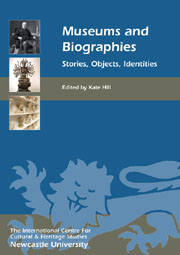Book contents
- Frontmatter
- Contents
- List of Illustrations
- Introduction: Museums and Biographies – Telling Stories about People, Things and Relationships
- INDIVIDUAL BIOGRAPHY AND MUSEUM HISTORY
- 1 A Show of Generosity: Donations and the Intimacy of Display in the ‘Cabinet des médailles et antiques’ in Paris from 1830 to 1930
- 2 Introducing Mr Moderna Museet: Pontus Hultén and Sweden's Museum of Modern Art
- 3 Sydney Pavière and the Harris Museum and Art Gallery, Preston
- PROBLEMATISING INDIVIDUALS' BIOGRAPHIES
- INSTITUTIONAL BIOGRAPHIES
- OBJECT BIOGRAPHIES
- MUSEUMS AS BIOGRAPHY
- MUSEUMS AS AUTOBIOGRAPHY
- Endpiece: The Homunculus and the Pantograph, or Narcissus at the Met
- List of Contributors
- Index
1 - A Show of Generosity: Donations and the Intimacy of Display in the ‘Cabinet des médailles et antiques’ in Paris from 1830 to 1930
from INDIVIDUAL BIOGRAPHY AND MUSEUM HISTORY
Published online by Cambridge University Press: 05 February 2013
- Frontmatter
- Contents
- List of Illustrations
- Introduction: Museums and Biographies – Telling Stories about People, Things and Relationships
- INDIVIDUAL BIOGRAPHY AND MUSEUM HISTORY
- 1 A Show of Generosity: Donations and the Intimacy of Display in the ‘Cabinet des médailles et antiques’ in Paris from 1830 to 1930
- 2 Introducing Mr Moderna Museet: Pontus Hultén and Sweden's Museum of Modern Art
- 3 Sydney Pavière and the Harris Museum and Art Gallery, Preston
- PROBLEMATISING INDIVIDUALS' BIOGRAPHIES
- INSTITUTIONAL BIOGRAPHIES
- OBJECT BIOGRAPHIES
- MUSEUMS AS BIOGRAPHY
- MUSEUMS AS AUTOBIOGRAPHY
- Endpiece: The Homunculus and the Pantograph, or Narcissus at the Met
- List of Contributors
- Index
Summary
In 1929, Jean Babelon, curator and future director of the Département des monnaies, médailles et antiques, better known as the Cabinet des médailles, claimed that the donations of individual benefactors had been of essential importance to forming an official science of archaeology, contributing to ‘constructing an edifice, which otherwise would not be standing today’ (Babelon 1929, 6). The metaphoric edifices he was referring to were the disciplines that had been developed to classify and understand the new material regrouped and housed in public archaeology museums; physical edifices such as the Cabinet des médailles et antiques.
Who were these benefactors, how should we write about them and how can their biographies contribute to a history of the museum? An administrative entity that displays objects, develops collections and operates scientifically as the haut lieu of the discipline of numismatics in France, the Cabinet des médailles is also, and perhaps most interestingly, a place where different groups of people cross paths. The network of collectors and researchers, the public (identified, named and studied as a milieu through the visitors’ book), and the employees themselves provide cases of different social and scientific practices, characterising what we might define as the identity of the institution that we want to portray. By concentrating on the principle of group ‘portraits’ and by considering the general characteristics of these different milieux, we may hope to give this institutional history a more varied and nuanced structure than more classical museum histories. Yet sometimes this essentially prosopographical thinking can blot out the preponderant importance of certain individual actors.
- Type
- Chapter
- Information
- Museums and BiographiesStories, Objects, Identities, pp. 13 - 28Publisher: Boydell & BrewerPrint publication year: 2012



